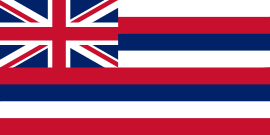Mokuʻula
Mokuʻula is a tiny island now buried beneath an abandoned baseball field in Maluʻulu o Lele Park, Lahaina, Hawaiʻi. It was the private residence of King Kamehameha III from 1837 to 1845 and the burial site of several Hawaiian royals. The 1-acre (4,000 m2) island was and continues to be considered sacred to many Hawaiians as a piko, or symbolic center of energy and power.[2] According to Klieger, "the moated palace of Mokuʻula...was a place of the "Sacred Red Mists," an oasis of rest and calm during the raucous, rollicking days of Pacific whaling."[3] When the capital of Hawaiʻi moved from Lahaina to Honolulu, Mokuʻula fell into disrepair. By 1919, the county turned the land into a park. Efforts were made to revive the site, but seem to have stalled[4]
King Kamehameha III's Royal Residential Complex | |
 Archeological site at Mokuʻula, September 2012. | |
 | |
| Location | Front and Shaw Streets, Maluʻulu o Lele and Kamehameha Iki Parks, Lahaina, Hawaiʻi |
|---|---|
| Coordinates | 20°52′10″N 156°40′29″W |
| Built | 1837 |
| NRHP reference No. | 97000408 [1] |
| Added to NRHP | May 9, 1997 |
It was added to the Hawaiʻi State Register of Historic Places on August 29, 1994, and to the National Register of Historic Places on May 9, 1997 as King Kamehameha III's Royal Residential Complex.
Loko o Mokuhinia
Mokuʻula was surrounded by Mokuhinia, a 17 acres (6.9 ha) spring-fed, wetland pond. The pond was reported to be the home of Kihawahine, a powerful moʻo or lizard goddess. According to myth, the moʻo was a reincarnation of Pi'ilani's daughter, the chiefess, Kalaʻaiheana. Hawaiians cultivated loʻi, or taro patches, and fishponds within Mokuhinia.[5]
Restoration
 |
| Moku‘ula Restoration Projects, Lahaina |
The Friends of Mokuʻula, a non-profit organization dedicated to restoration of the sacred site, formed in 1990. Members lead tours of the area. As of 2020, it appears to be inactive. From 1992–1995 and in 1999, archaeologists from Bishop Museum and Heritage Surveys surveyed the site and documented its features and boundaries.
References
- "National Register Information System". National Register of Historic Places. National Park Service. April 15, 2008.
- Becker, Nancy; Leonard Becker (1999). "Mokuʻula A Native Hawaiian Sacred Site is Being Restored". Preservation. Sacred Sites International Foundation. Archived from the original on 2008-08-07. Retrieved 2008-07-14.
- Klieger, P. Christiaan (Jan 2003). "Mokuʻula: The King's Island". Maui No Ka ʻOi i Magazine. 6 (4). Archived from the original on 2011-06-10. Retrieved 2009-08-17.
- Kubota, Gary T. (2003-07-10). "Group works to restore islet". Hawaiʻi News. Honolulu Star-Bulletin. Retrieved 2008-07-14.
- Schonwalter, Helen Anne (2007-02-22). "Mokuʻula Reawakens". Features. Maui Weekly. Archived from the original on 2008-10-11. Retrieved 2008-07-14.
Further reading and resources
- Hamilton, Chris (2010-03-14). "In dig project, what's 'underneath' matters". Maui News.
- James, Van (2001). Ancient Sites of Maui, Molokaiʻi and Lanaʻi. Honolulu, HI: Mutual Publishing. pp. 48–52. ISBN 1-56647-529-5.
- Kamae, Eddie (Director); Wong, Kaupena (Actor) (2008). Lahaina – Waves of Change (Documentary). Hawaiian Legacy Foundation.
- Klieger, P. Christiaan (1999). Mokuʻula: Maui's Sacred Island. Bishop Museum Press. ISBN 1-58178-002-8.
- Wyban, Carol Araki (1992). Tide and Current: Fishponds of Hawaiʻi. Honolulu, HI: University of Hawaiʻi Press. ISBN 0-8248-1396-0.
External links
| Wikimedia Commons has media related to Mokuʻula. |
- Friends of Mokuʻula Official Site
- Lahaina's Invisible Island Maui No Ka 'Oi Magazine Jan/Feb 2009.
